Vered Neta's Blog, page 7
May 30, 2024
The Self-Publishing Playbook – 10 Essential Tips.
Congratulations on reaching this milestone!
Completing your fiction book is no small feat – it’s a testament to your dedication and creativity. Now, you’re eager to share your story with the world, but navigating the path to publication can feel like a daunting task, especially for new authors like yourself.
Fear not! Whether you’re considering traditional publishing or exploring the empowering world of self-publishing, I’m here to guide you through the process with these 10 essential tips.
10 Essential Tips For Self Publishing
 #1 – Understand Your Goals.
#1 – Understand Your Goals.
Take a moment to reflect on your goals as an author. Are you aiming to captivate a wide audience, secure a steady income, or simply share your story with the world?
Knowing your objectives will shape your self-publishing journey.
#2 – Research Self-Publishing Platforms.
There’s a plethora of self-publishing platforms out there, each offering unique features and benefits.
From Amazon Kindle Direct Publishing (KDP) Smashwords, Draft2Digital, Kobo, and IngramSpark are just to name a few of them. Find out which one is the best fit for your needs.
#3 – Polish Your Manuscript.
This might seem obvious, but a professionally edited and proofread manuscript is crucial for establishing credibility and ensuring a smooth reading experience.
A polished manuscript is key to standing out in the competitive world of self-publishing. Consider enlisting the help of a professional editor to ensure your work is free of errors and inconsistencies.
Quality editing doesn’t have to break the bank – platforms like Fiverr offer affordable options.
#4 – Create a Captivating Cover.
They say don’t judge a book by its cover, but let’s be real – readers are drawn to eye-catching designs.
Invest in a professionally designed cover that captures the essence of your story and entices readers to dive in.
Don’t worry about breaking the bank – talented graphic designers on platforms like Fiverr offer high-quality designs at affordable prices.

#5 – Develop a Marketing Plan.
As a self-published author, you’re your own marketing team.
Craft a comprehensive marketing plan that includes strategies for building your author platform, engaging with readers on social media, and promoting your book to your target audience.
#6 – Utilise Pre-Order Options.
Generate buzz and excitement for your book by taking advantage of pre-order options offered by self-publishing platforms.
Pre-orders can boost your book’s visibility and sales rankings ahead of its release.
#7 – Leverage Kindle Direct Publishing Select.
Consider enrolling your book in Kindle Direct Publishing Select (KDP Select) to access additional marketing and promotional opportunities, such as Kindle Countdown Deals and Kindle Unlimited.
#8 – Monitor Sales and Analytics.
Stay informed about your book’s performance by regularly monitoring sales reports and analytics provided by self-publishing platforms.
Use this data to track trends, identify areas for improvement, and refine your marketing strategies.
 #9 – Build Relationships with Reviewers and Bloggers.
#9 – Build Relationships with Reviewers and Bloggers.
Positive reviews and recommendations can significantly impact your book’s success.
Reach out to reviewers and bloggers in your genre and offer review copies in exchange for honest feedback.
#10 – Connect with Your Reader Community.
Cultivate a loyal reader base by engaging with readers through social media, author newsletters, and virtual events.
Building a strong connection with your audience is essential for long-term success as a self-published author.
In Conclusion – Embarking on the self-publishing journey as a new fiction author is an exciting adventure.
Following these 10 essential tips, you’ll be well-equipped to navigate the self-publishing landscape and embark on a successful author journey. Remember, perseverance, patience, and a passion for storytelling are key ingredients for success in self-publishing.
Now it’s YOUR turn – Let me know what would YOU like to know about Self-Publishing and what are YOUR tips
Would love to get your input in the comment box below.
The post The Self-Publishing Playbook – 10 Essential Tips. appeared first on Vered Neta.
The Self-Publishing Playbook – 10 Essential Tips
Congratulations on reaching this milestone!
Completing your fiction book is no small feat – it’s a testament to your dedication and creativity. Now, you’re eager to share your story with the world, but navigating the path to publication can feel like a daunting task, especially for new authors like yourself.
Fear not! Whether you’re considering traditional publishing or exploring the empowering world of self-publishing, I’m here to guide you through the process with these 10 essential tips.
10 Essential Tips For Self Publishing
 #1 – Understand Your Goals.
#1 – Understand Your Goals.
Take a moment to reflect on your goals as an author. Are you aiming to captivate a wide audience, secure a steady income, or simply share your story with the world?
Knowing your objectives will shape your self-publishing journey.
#2 – Research Self-Publishing Platforms.
There’s a plethora of self-publishing platforms out there, each offering unique features and benefits.
From Amazon Kindle Direct Publishing (KDP) Smashwords, Draft2Digital, Kobo, and IngramSpark are just to name a few of them. Find out which one is the best fit for your needs.
#3 – Polish Your Manuscript.
This might seem obvious, but a professionally edited and proofread manuscript is crucial for establishing credibility and ensuring a smooth reading experience.
A polished manuscript is key to standing out in the competitive world of self-publishing. Consider enlisting the help of a professional editor to ensure your work is free of errors and inconsistencies.
Quality editing doesn’t have to break the bank – platforms like Fiverr offer affordable options.
#4 – Create a Captivating Cover.
They say don’t judge a book by its cover, but let’s be real – readers are drawn to eye-catching designs.
Invest in a professionally designed cover that captures the essence of your story and entices readers to dive in.
Don’t worry about breaking the bank – talented graphic designers on platforms like Fiverr offer high-quality designs at affordable prices.

#5 – Develop a Marketing Plan.
As a self-published author, you’re your own marketing team.
Craft a comprehensive marketing plan that includes strategies for building your author platform, engaging with readers on social media, and promoting your book to your target audience.
Need a little guidance? Download my free Ebook on Self-Publishing 101.
#6 – Utilise Pre-Order Options.
Generate buzz and excitement for your book by taking advantage of pre-order options offered by self-publishing platforms.
Pre-orders can boost your book’s visibility and sales rankings ahead of its release.
#7 – Leverage Kindle Direct Publishing Select.
Consider enrolling your book in Kindle Direct Publishing Select (KDP Select) to access additional marketing and promotional opportunities, such as Kindle Countdown Deals and Kindle Unlimited.
#8 – Monitor Sales and Analytics.
Stay informed about your book’s performance by regularly monitoring sales reports and analytics provided by self-publishing platforms.
Use this data to track trends, identify areas for improvement, and refine your marketing strategies.
 #9 – Build Relationships with Reviewers and Bloggers.
#9 – Build Relationships with Reviewers and Bloggers.
Positive reviews and recommendations can significantly impact your book’s success.
Reach out to reviewers and bloggers in your genre and offer review copies in exchange for honest feedback.
#10 – Connect with Your Reader Community.
Cultivate a loyal reader base by engaging with readers through social media, author newsletters, and virtual events.
Building a strong connection with your audience is essential for long-term success as a self-published author.
In Conclusion – Embarking on the self-publishing journey as a new fiction author is an exciting adventure.
Following these 10 essential tips, you’ll be well-equipped to navigate the self-publishing landscape and embark on a successful author journey. Remember, perseverance, patience, and a passion for storytelling are key ingredients for success in self-publishing.
For more in-depth understanding and tips download my free eBook on Self-Publishing 101
Now it’s YOUR turn – Let me know what would YOU like to know about Self-Publishing and what are YOUR tips
Would love to get your input in the comment box below.
The post The Self-Publishing Playbook – 10 Essential Tips appeared first on Vered Neta.
May 23, 2024
Winter is Still Coming – Why Game of Thrones Changed TV.
It’s hard to believe it’s been 13 years since Westeros first graced our screens. April 17, 2011, marked the premiere of Game of Thrones, a series that would leave an indelible mark on television history.
But what made it such a phenomenon? Why are we still talking about it over a decade later?
Here are 7 reasons Game of Thrones succeeded.

#1 – Moral Complexity – Shattering the Hero-Villain Mold.
Gone were the days of clear-cut heroes and villains. In traditional storytelling, characters often fit neatly into the categories of heroes or villains, with clear-cut distinctions between good and evil.
However, Game of Thrones shattered this simplistic paradigm by presenting characters with complex moral alignments and shades of grey.
Characters like Daenerys Targaryen exemplify this complexity, as her journey from a seemingly benevolent liberator to a ruthless conqueror challenges viewers’ perceptions and forces them to grapple with the ambiguity of her actions.
Or take Jaime Lannister, known as the “Kingslayer,” who initially appears as a quintessential villain in the early seasons of Game of Thrones. He is introduced as an arrogant and morally ambiguous character, infamous for betraying his oath as a knight by slaying the “Mad King” Aerys II Targaryen. His incestuous relationship with his sister, Cersei, further cements his image as a villain in the eyes of many viewers.
However, as the series progresses, Jaime undergoes a profound transformation that challenges the audience’s perception of him. Jaime exhibits genuine heroism and selflessness through his interactions with characters like Brienne of Tarth and his own internal struggles. His complex motivations and internal conflicts reveal layers of depth previously unseen, humanising him in the eyes of the audience.
Lesson for Screenwriters: Create characters with depth and understandable motivations, even if they walk a dark path. A well-rounded antagonist can be just as compelling as a hero.
 #2 – The Unpredictable Throne – Keeping Audiences on the Edge.
#2 – The Unpredictable Throne – Keeping Audiences on the Edge.
Remember the Red Wedding? Yeah, us, too. Game of Thrones (GOT) became renowned for its penchant for keeping viewers on the edge of their seats, never quite knowing what twists and turns awaited them in each episode.
One of the most iconic examples of this unpredictability is the infamous “Red Wedding”. What began as a seemingly joyous occasion quickly descended into a massacre, shocking audiences worldwide and solidifying the show’s reputation for defying expectations.
However, it wasn’t just singular moments of shock that kept audiences engaged; the pervasive sense of uncertainty permeated the entire series. From the deaths of major characters to the unexpected alliances and betrayals, GOT continuously subverted traditional narrative tropes, leaving viewers guessing and eagerly anticipating what would happen next..
Lesson for Screenwriters: Feel free to surprise your audience. Play with expectations, raise the stakes, and deliver shocking twists.
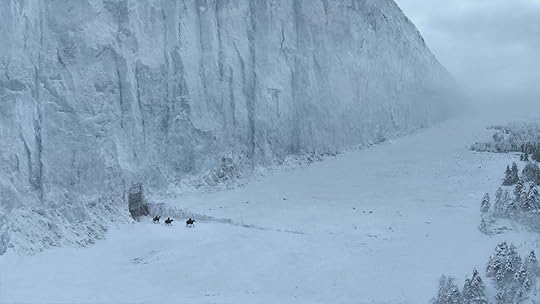
#3 – A World You Can Live In – The Power of Rich World-Building.
GOT transported audiences to the fictional continents of Westeros and Essos, immersing them in a meticulously crafted world that felt alive and vibrant.
George R.R. Martin’s detailed world-building provided a solid foundation for the series, allowing viewers to explore diverse cultures, landscapes, and histories.
King’s Landing, the capital of the Seven Kingdoms, is an excellent example, from the towering Red Keep to the bustling streets of Flea Bottom. King’s Landing was brought to life with intricate set design, costume work, and visual effects. The city’s complex political dynamics, including the machinations of the ruling Lannister family and the influence of the religious organisation known as the Faith of the Seven, added depth to the narrative.
Another example is the Wall and the lands beyond it, where the Night’s Watch defends the realm from threats beyond the northern border. The icy landscapes of the North, inhabited by wildlings, giants, and mythical creatures, starkly contrasted with the political intrigue of the Southern kingdoms. The Wall, a colossal barrier of ice stretching across the northern border, served as a symbol of protection and isolation, further enriching the world of GOT.
Lesson for Screenwriters: Invest time in crafting your world. Develop its history, culture, and details. The more immersive your world, the deeper viewers will be drawn into your story.

#4 – Cinematic Spectacle – Raising the Bar for Production Quality.
HBO threw down the gauntlet with GOT’s lavish production values. With its breathtaking visuals, elaborate costumes, and epic set pieces, GOT set a new standard for television production.
The show spared no expense in creating a cinematic experience for its audience, rivalling the production values of blockbuster films.
One standout example is the epic “Battle of the Bastards”. The battle, which depicts Jon Snow’s forces facing off against Ramsay Bolton’s army for control of Winterfell, is a masterclass in visual storytelling. From the chaotic melee on the battlefield to the soaring aerial shots capturing the scale of the conflict, every aspect of the battle was meticulously choreographed and executed.
The production team spared no expense in creating the immersive battlefield environment, with hundreds of extras, elaborate practical effects, and state-of-the-art visual effects combined to create a sense of epic scale and intensity. The result is a sequence that rivals the intensity and spectacle of any big-budget Hollywood blockbuster, demonstrating GOT’s‘ ability to deliver cinematic quality on the small screen.
Lesson for Screenwriters: While a great story is essential, strong visuals can elevate your project. If your vision demands a grand scope, fight for the resources to bring it to life.
[image error]
#5 – A Song of Ice and Scope – Juggling Multiple Storylines
GOT masterfully weaved together a complex narrative with numerous storylines spread across continents.
One of the show’s greatest strengths is its ability to seamlessly transition between these diverse plot threads, keeping viewers engaged and invested in the fates of characters both major and minor.
The Stark family is a fantastic example of it. They are scattered across the Seven Kingdoms and beyond while following the events of the War of the Five Kings. From Jon Snow’s adventures beyond the Wall to Arya Stark’s journey across the Narrow Sea, each Stark sibling experiences their own trials and tribulations, which ultimately converge in a satisfying and emotionally resonant manner.
Another example is the political intrigue in King’s Landing, where characters like Tyrion Lannister, Cersei Lannister, and Tywin Lannister vie for power and influence in the wake of King Robert Baratheon’s death. The complex web of alliances and betrayals in the capital city provides a rich backdrop for some of the show’s most memorable moments, including Tyrion’s trial and the rise of the Faith Militant.
Lesson for Screenwriters: Don’t be afraid of an ambitious narrative. With careful planning and execution, you can juggle multiple storylines while keeping your audience invested.
[image error]#6 – A Language We Can All Understand – Universality in Themes.
Beneath the dragons and battles, GOT explored universal themes. It transcended its fantasy and explored themes that resonate with audiences across cultures and backgrounds.
The series delved into fundamental aspects of the human experience, including love, power, loyalty, and betrayal.
One of those universal themes is the pursuit of power and its corrupting influence. Characters like Cersei Lannister and Petyr Baelish exemplify the lengths to which individuals will go to seize and maintain control, often at the expense of others.
Their Machiavellian machinations and ruthless ambition serve as cautionary tales about the dangers of unchecked ambition and the corrupting nature of power.
Another example is the theme of redemption and forgiveness, epitomised by characters like Jaime Lannister and Theon Greyjoy. Both characters begin the series as morally ambiguous figures known for their past transgressions and betrayals.
However, over the course of the series, they undergo profound transformations and seek redemption for their past sins, ultimately finding a sense of redemption and forgiveness in the eyes of others and themselves.
Lesson for Screenwriters: Weave universal themes into the fabric of your story. Grand fantasy or heart-wrenching drama, stories that connect with the human condition will resonate with a broader audience.

#7 – The Legacy Lives On – A Show that Changed Television.
GOT redefined the landscape of television. It proved that high fantasy epics could be critically acclaimed mainstream hits, pushing boundaries in storytelling, production value, and audience engagement.
No wonder it led to big productions such as “Ring of Power” and “House of Dragons.” just to name a few of them.
Lesson for Screenwriters: There’s always room to push boundaries. strive to create something innovative and different, a show that will leave its own mark on television history.
In Conclusion – Even 13 years later, GOT reminds us that storytelling is a journey of endless possibility. While we might not all get a shot at dragons and epic battles, we can still rock our own writing kingdoms.
So, let’s channel our inner Khaleesi or Jon Snow and craft stories that are as wild and wonderful as a trip beyond the Wall. Because, in the end, it’s not about the size of the budget—it’s about the size of the heart we pour into our tales.
Now it’s YOUR turn – Imagine you could write a different ending for Game of Thrones. How would you have concluded the series?
Would love to get your input in the comment box below.
The post Winter is Still Coming – Why Game of Thrones Changed TV. appeared first on Vered Neta.
May 9, 2024
Unlocking Suspense: 7 Secrets to Crafting Riveting Narratives
Have you ever devoured a book or binge-watched a show so fast it felt like time travel? That’s the power of a gripping story – it keeps you on the edge of your seat, desperate to know what happens next. But how do you, the writer, weave that kind of magic?
Here Are 7 Ways to Take Your Narrative from Predictable to Pulse-Pounding.[image error]
#1 – Plant the Seeds of Suspense with Foreshadowing.
Imagine dropping hints about a future plot twist – like planting tiny seeds that sprout into a chilling surprise later. That’s foreshadowing!
It can be subtle, like a character mentioning their fear of heights or a seemingly ordinary object that keeps reappearing. These hints build anticipation and add depth to your story, making the reveal even more satisfying.
In the movie “The Dark Knight,” director Christopher Nolan masterfully foreshadows Harvey Dent’s tragic fate. Remember when Harvey talks about chance and fate, saying, “You make your own luck“? That wasn’t just random dialogue! It foreshadowed the events that would turn Harvey into the vengeful Two-Face.
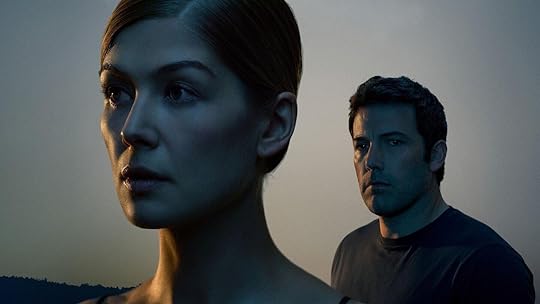 #2 – The Unreliable Narrator: When Trust Takes a Twist.
#2 – The Unreliable Narrator: When Trust Takes a Twist.
Have you ever met someone who embellishes stories or forgets things conveniently? In fiction, this can be a narrator!
They may be intentionally misleading you, have a limited understanding of events, or are simply biased. This creates a delicious mystery – who can you believe?
For instance, in Gillian Flynn’s “Gone Girl”, the story unfolds from the perspectives of Nick and Amy Dunne. Their conflicting accounts leave you questioning everything—who’s telling the truth, and what dark secrets lurk beneath the surface?.
[image error]
#3 – Cliffhangers: The Ultimate Page-Turner.
Have you ever reached the end of a chapter and slammed the book shut (or frantically hit “next episode”) because things got SO intense? That’s the cliffhanger at work!
It throws a curveball right before you stop reading, leaving a major plot point unresolved or a character in danger. Talk about a guaranteed way to keep you hooked!
“Game of Thrones” is known for its cliffhangers. One unforgettable instance is Season 1, Episode 9, where Eddard Stark faces execution. Just as the sword falls, the scene cuts to black! Genius, right? It left everyone desperate to find out Eddard’s fate and what it meant for the future of Westeros.
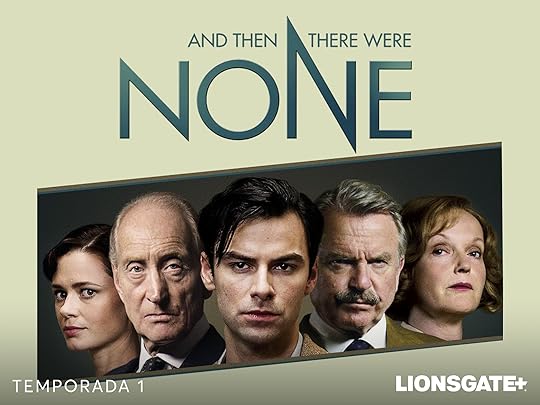
#4 – Red Herrings: The Art of the Misdirection.
Imagine a detective story where you think you have the culprit figured out, only to discover you’ve been completely misled.
That’s the power of the red herring! It’s a false clue or event that throws you off the scent, adding suspense and keeping you guessing.
The queen of red herrings was Agatha Christie! In her novel “And Then There Were None,” ten strangers are invited to a secluded island. As they start dying one by one, suspicion falls on Dr. Armstrong.
He seems suspicious – a doctor with access to deadly substances? But there is a plot twist! Dr. Armstrong is a red herring. His strange behaviour has a different explanation, and the true killer is still out there!
[image error]
#5 – Sudden Reveals: The Twist You Never Saw Coming.
Remember that movie where everything you thought you knew gets shattered in an instant? That’s the power of the sudden reveal, also known as a plot twist.
These unexpected turns of events completely change the story, leaving you stunned and eager to see how it all unfolds.
The most well-known one is probably in M. Night Shyamalan’s “The Sixth Sense.” Throughout the film, we follow child psychologist Malcolm Crowe as he treats Cole, a boy who sees dead people.
The movie is packed with spooky moments, but the real shocker comes at the very end: Dr. Crowe himself is a ghost! This revelation flips the entire story on its head, making you re-evaluate everything you thought you knew. Talk about a twist you never saw coming!
 #6 – Ticking Clock: Race Against Time.
#6 – Ticking Clock: Race Against Time.
Ever get that feeling of being on a roller coaster? Heart pounding, palms sweating, barely able to catch your breath? That’s the power of the ticking clock technique in action movies!
This trick is all about creating a race against time, a deadline that forces the characters to act fast. It throws them (and us, the viewers!) headfirst into danger, raising the stakes and pushing them to make tough choices before everything explodes (literally or figuratively!).
Need an example? Look no further than “Speed,” the 1994 action-thriller starring Keanu Reeves and Sandra Bullock. Remember that iconic city bus bomb set to go off if it dips below 50 mph? That’s a textbook ticking clock!
From the moment that bomb is discovered, the pressure is on. Jack (Keanu Reeves) and Annie (Sandra Bullock) have to keep the bus moving, defuse the bomb, and save everyone on board – all while that clock keeps ticking! It’s a constant race against time, a rollercoaster ride of obstacles, challenges, and the very real threat of a fiery explosion.
This technique isn’t just about thrills, though. “Speed” also highlights themes of heroism, quick thinking under pressure, and the sacrifices people make in desperate situations. By using the ticking clock so well, the movie keeps us hooked from start to finish, making it a classic example of how this technique can take storytelling to the next level.
So, the next time you see an action movie with a countdown or a bomb threat, remember the ticking clock! That invisible force keeps the action pumping, the tension high, and the audience right on the edge of their seats.
[image error]
#7 – Wild Cards: Why Unpredictable Characters Rule.
Characters are the driving force in a well-crafted narrative. But what truly keeps readers hooked is encountering characters who defy expectations and make surprising choices.
These unpredictable characters are the wild cards of storytelling, injecting a sense of uncertainty and intrigue into the plot.
Here’s why unpredictable characters are so compelling:
Subverted Tropes: They challenge reader assumptions about character archetypes. We expect the hero to be selfless and the villain to be cruel, but unpredictable characters can blur these lines. This keeps the reader guessing their motivations and makes their actions less predictable.Heightened Suspense: Unpredictable characters create a sense of mystery. The reader can’t be sure what they’ll do next, which keeps the story suspenseful and engaging.Deeper Character Exploration: Unpredictable characters often have complex motivations and hidden depths. Exploring these complexities can make them more interesting and relatable.My favourite example is Kaz Brekker from Six of Crows by Leigh Bardugo. If you haven’t read the book you might have seen this character in the TV show “Shadow and Bone.”
Kaz Brekker, the main protagonist of Leigh Bardugo’s Six of Crows, is a brilliant criminal mastermind known for his strategic thinking and ruthless efficiency. His unpredictable nature makes him a fascinating and compelling character.
Kaz operates in a morally grey area. He’s willing to partner with anyone, even his rivals if it serves his ultimate goal. This keeps the reader guessing who he trusts and’ll ultimately betray.
While Kaz prioritises wealth and power, glimpses of a troubled past and a surprising loyalty to his crew emerge throughout the story. These unexpected depths challenge the reader’s perception of him as a purely self-serving criminal.
Kaz is known for his calculated plans, but he’s also capable of making impulsive decisions based on personal vendettas or a desire to protect those he cares about. This unpredictability keeps the reader on edge, unsure of how to react to any situation.
Kaz’s unpredictability adds a layer of suspense and intrigue to Six of Crows. The reader can’t be sure what his next move will be, keeping the plot in motion. It also forces the other characters and readers to be on guard, constantly unsure of his true intentions.
This example showcases how unpredictable characters can be effective without relying on shocking darkness. Kaz’s unpredictability comes from his complex motivations, shifting alliances, and the potential for both ruthless ambition and surprising loyalty.
In Conclusion – Using some of these techniques, you can craft a narrative that keeps your readers guessing, engaged, and utterly hooked until the last page. Remember, tension and surprise are the spices that make your story come alive!
Now it’s YOUR turn – Are cliffhangers a cheap trick or genius? What say you?
Would love to get your input in the comment box below.
The post Unlocking Suspense: 7 Secrets to Crafting Riveting Narratives appeared first on Vered Neta.
May 2, 2024
Spice Up Your Life: Dune Part 2 – Book vs. Big Screen
Directed: Denis Villeneuve
Writer: Denis Villeneuve & Jon Spaihts (screenplay) & Frank Herbert (novel)
Starring: Timothée Chalamet, Zendaya, Javier Bardem, Rebecca Ferguson
Trivia: The term ‘Kwisatz Haderach‘ refers to the Hebrew Kefitzat Haderech which means a miraculous journey between two distant places in a brief time.
**************************
Someone once told me that sci-fi is a fantasy book in the future, and while most fantasy books resemble history, sci-fi takes it into the future. Though it was an intriguing argument that made me like sci-fi, I was not convinced as I liked my fantasy books because of the feeling of ancient history. But there was one big exception to it: Dune. I loved that book and all its sequels.
In 2021, Denis Villeneuve‘s Dune managed to do justice to the original source. It captivated my heart and other audiences with his version of the cinematic adaptation of this book. He was able to take us on a visually stunning journey to the desert planet Arrakis.
Now, Dune Part Two is here, promising to delve deeper into Frank Herbert’s legendary sci-fi saga. With a bit of scepticism, I went to watch it on the big screen. I’m not a big fan of Part 2 for successful movies. I was curious to see how closely the movie follows the book.
So, Let’s Spice Things Up and See How They Compare. Faithful Adaptation.
Faithful Adaptation.
The core plot of Dune Part Two stays true to the novel’s foundation. We witness Paul Atreides (Timothee Chalamet) grappling with his messianic destiny as he leads the Fremen.
Political intrigue simmers as Paul navigates the complex web of alliances and betrayals on Arrakis. Key characters like Chani (Zendaya) and Stilgar (Javier Bardem) receive more development, offering a glimpse into the Fremen’s unique culture and motivations.
 Ecology and Exploitation.
Ecology and Exploitation.
Herbert’s novel fiercely critiques the exploitation of natural resources for short-term gain.
Spice, the lifeblood of the Padishah Emperor’s galactic empire, represents this exploitation.
The movie retains this theme, highlighting the Fremen’s deep respect for the desert ecology and their sustainable harvesting practices in contrast to the Harkonnens’ destructive methods.
The Spice of Choice.
Ultimately, the exploration of these themes is one of the strengths of both the movie and the book.
They challenge viewers to contemplate the dangers of unchecked power, the importance of environmentalism, and the thin line between faith and fanaticism.
Whether you experience these themes on the silver screen or delve into the rich tapestry of the novel, Dune offers a thought-provoking exploration of humanity’s potential and pitfalls.
 Faith and Fanaticism.
Faith and Fanaticism.
The Fremen’s reverence for Paul as their prophesied messiah, Muad’Dib, is a double-edged sword. Both the book and the movie explore the dangers of blind faith and the potential for charismatic leaders to manipulate religious fervour for their own ends.
The film portrays Chani and Stilgar questioning Paul’s path, hinting at the potential for a Fremen rebellion if Paul succumbs to the darker aspects of power.
Where the Sands Shift – Omissions and Alterations.
However, adapting a sprawling novel inevitably leads to changes. While the movie captures the essence of these themes, some argue it simplifies them. The book delves deeper into the political and economic machinations behind spice harvesting, highlighting the complex power dynamics at play. The Fremen’s religious beliefs are explored in greater detail in the novel, revealing a rich mythology that adds depth to their culture.
 Here’s where the movie deviates from the book:The Two-Year Time Jump: The book features a crucial two-year jump after Paul escapes the desert. This period allows Paul and Chani to develop a deeper bond, witness the birth of their son Leto II, and solidify Paul’s place as the Fremen’s leader. The movie condenses this timeframe, potentially impacting the emotional weight of Paul’s journey.Alia’s Absence: Alia Atreides, Paul’s younger sister, plays a significant role in the novel. Born with Other Memory, a precognitive ability, she becomes a potent political and religious figure. The movie omits Alia entirely, potentially confusing some viewers about her importance in future instalments.Thufir Hawat’s Intrigue: The Mentat Hawat plays a complex role in the book, navigating the political landscape and serving as a source of both guidance and manipulation for Duke Leto (Paul Astreid’s father). The film essentially removes this subplot, streamlining the narrative but diminishing the political complexity.The Water of Life: The ritualistic use of the spice melange, known as the Water of Life, is a pivotal moment in the book, granting Paul heightened visions and a deeper understanding of his destiny. The movie simplifies this scene, potentially undercutting the impact of Paul’s transformation.
Here’s where the movie deviates from the book:The Two-Year Time Jump: The book features a crucial two-year jump after Paul escapes the desert. This period allows Paul and Chani to develop a deeper bond, witness the birth of their son Leto II, and solidify Paul’s place as the Fremen’s leader. The movie condenses this timeframe, potentially impacting the emotional weight of Paul’s journey.Alia’s Absence: Alia Atreides, Paul’s younger sister, plays a significant role in the novel. Born with Other Memory, a precognitive ability, she becomes a potent political and religious figure. The movie omits Alia entirely, potentially confusing some viewers about her importance in future instalments.Thufir Hawat’s Intrigue: The Mentat Hawat plays a complex role in the book, navigating the political landscape and serving as a source of both guidance and manipulation for Duke Leto (Paul Astreid’s father). The film essentially removes this subplot, streamlining the narrative but diminishing the political complexity.The Water of Life: The ritualistic use of the spice melange, known as the Water of Life, is a pivotal moment in the book, granting Paul heightened visions and a deeper understanding of his destiny. The movie simplifies this scene, potentially undercutting the impact of Paul’s transformation. Chani’s Character Arc.
Chani’s Character Arc.
Chani, Paul’s Fremen love, undergoes a significant shift in the movie. While the core elements of their relationship remain, the film portrays Chani and the Fremen with a more modern and progressive lens, potentially diverging from Herbert’s portrayal of a deeply superstitious and ritualistic culture.
Rushing Through the Sand.
The fast pace of the movie is another point of contention. The book takes its time to establish intricate world-building and character motivations. The film, on the other hand, condenses a significant portion of the plot, potentially leaving viewers feeling like they’re being rushed through the story.
Characters vs. Spectacle:
The grand scale of the story might overshadow some character development. While the acting is strong, viewers who crave a deeper dive into the characters’ motivations might leave the theatre wanting more.
The Verdict.
Whether you’re a Dune devotee or a newcomer, Dune Part Two offers a visually spectacular and engaging cinematic experience. While the film might skim over some details from the book, it serves as a fantastic gateway to Herbert’s rich universe.
So, grab your popcorn (or spice melange), and prepare to be swept away by the epic tale of Paul Atreides!
My Final Verdict – 5/5 StarsNow it’s YOUR Turn – Are you Team Book or Team Movie? Why do you prefer experiencing Dune in one format over the other?
Let me know in the comment box below
The post Spice Up Your Life: Dune Part 2 – Book vs. Big Screen appeared first on Vered Neta.
April 25, 2024
The Hidden Character: How Setting Shapes Stories.
Last week, I shared some tips on building worlds in writing, whether for scripts or novels. As I dove into a new novel set in the Cotswolds this week—a cosy mystery, not a fantasy or sci-fi—I rediscovered how much a location can influence a story, almost becoming a character of its own.
As part of my writing process (or procrastination, if we’re being honest!), I delved deeper into this topic and uncovered exciting ways to use location as a dynamic force in storytelling. The setting isn’t just a backdrop; it’s a vital element that can shape the narrative, influence character development, and evoke specific emotions in readers or viewers. Let’s explore how you can harness the power of location to enrich your storytelling experience.
Here Are 5 Ways How a Location Influences Your Story.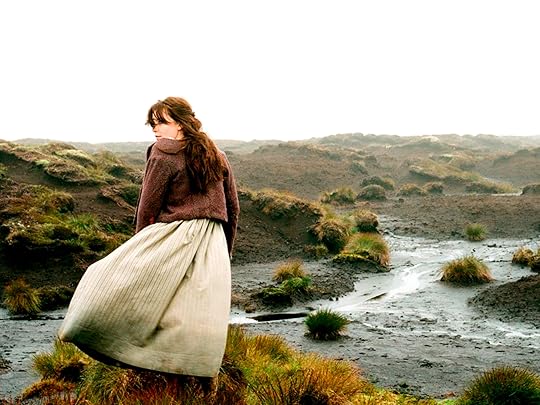 #1 – Establishing Mood and Atmosphere.
#1 – Establishing Mood and Atmosphere.
The mood and atmosphere of a story are profoundly shaped by its setting, incorporating geographical features, weather patterns, and cultural elements. A well-described setting can evoke emotions and immerse the audience in the narrative experience.
Take Emily Brontë’s timeless novel “Wuthering Heights,” where the Yorkshire moors play a pivotal role in establishing a haunting and tumultuous atmosphere. The isolated, windswept moorland surrounding the titular estate mirrors the wild and untamed passions of characters like Heathcliff and Catherine Earnshaw. The rugged landscape, with its harsh weather and desolate vistas, reflects the tempestuous relationships and emotional turmoil within.
The relentless wind and unpredictable weather intensify the brooding atmosphere, emphasising themes of nature’s power and the uncontrollable forces of passion and revenge. The setting itself feels alive, almost like a character influencing the actions and fates of its inhabitants. Brontë’s vivid descriptions of the moors create a sense of foreboding and mystery, drawing readers into the dark and tumultuous world of “Wuthering Heights.”
In this example, the Yorkshire moors are not just a backdrop but a vital component of the story’s emotional landscape. Through meticulously crafted mood and atmosphere, Brontë enhances the depth and intensity of her narrative, making the location an integral part of the storytelling experience.
When considering the impact of setting on mood and atmosphere in your own writing, think about how different elements of your chosen location—such as weather, geography, or architectural features—can evoke specific emotions and contribute to the overall tone of your story. By immersing your readers in a richly detailed setting that resonates with the themes and emotions of your narrative, you can create a powerful and evocative storytelling experience.
 #2 – Influencing Characters and Relationships.
#2 – Influencing Characters and Relationships.
The setting of a story can profoundly influence the behaviours, beliefs, and interactions of its characters, shaping the dynamics of relationships within the narrative.
In Sofia Coppola’s film “Lost in Translation,” the bustling city of Tokyo serves as a dynamic and transformative backdrop that deeply impacts the characters’ emotions and relationships.
Cultural Isolation: Bob Harris (played by Bill Murray) and Charlotte (played by Scarlett Johansson) find themselves in a foreign city, navigating cultural and linguistic barriers. Tokyo’s vibrant yet unfamiliar atmosphere intensifies their sense of isolation and disconnection, leading them to form a unique bond as fellow outsiders.Sense of Alienation: Against Tokyo’s sprawling urban landscape—illuminated by neon lights, crowded streets, and bustling nightlife—Bob, a middle-aged actor disillusioned with his career and marriage, and Charlotte, a young woman questioning her purpose and identity, share a palpable feeling of displacement and existential weariness. This setting draws them together despite their differing life stages and experiences.Intimacy and Connection: Amidst Tokyo’s sensory overload, Bob and Charlotte’s relationship deepens as they explore the city together, sharing intimate moments of introspection. The setting facilitates a profound emotional connection between the characters, transcending language barriers and societal expectations.Reflection of Internal States: Tokyo’s blend of modernity and tradition mirrors Bob and Charlotte’s internal struggles and emotional journeys. The juxtaposition of ancient temples and high-tech innovations symbolises their contrasting perspectives on life and the passage of time. The setting poignantly reflects their inner turmoil and longing for authenticity in a superficial world.Through its evocative portrayal of Tokyo, “Lost in Translation” illustrates how setting can shape characters’ emotional landscapes and interpersonal dynamics. The city’s energy and visual richness serve as a catalyst for personal growth and self-discovery, ultimately fostering a transformative connection between two lost souls.
When crafting your own stories, consider how the setting can mirror your characters’ internal conflicts, emotional states, and relationships. Whether exploring a bustling metropolis, a serene natural landscape, or a historical period, leverage the unique characteristics of your chosen setting to enrich your characters’ experiences and deepen the thematic resonance of your narrative. By integrating the setting as a dynamic and integral element of your storytelling, you can enhance your characters’ journeys’ emotional depth and authenticity.

#3 – Driving Conflict and Plot.
In many narratives, the setting plays a pivotal role beyond mere backdrop—actively drives conflicts and propels the plot forward.
Take “The Martian” as an example, where the setting of Mars serves as a compelling backdrop that drives conflict and influences the protagonist’s actions and decisions throughout the story.
Hostile and Isolated Environment: After a mission gone awry, stranded astronaut Mark Watney faces a relentless series of challenges on Mars. The planet’s barren, desolate landscape—with its extreme temperatures, thin atmosphere, and scarce resources—becomes a formidable antagonist that Mark must overcome to survive.
Survival Against All Odds: Mark’s struggle for survival on Mars becomes the central focus of the plot, amplifying the stakes of his predicament. From food shortages to equipment failures and constant exposure to harsh conditions, the hostile environment drives the urgency of Mark’s mission to find innovative solutions and adapt to his surroundings.Problem-Solving and Ingenuity: Mars’s setting highlights Mark’s resourcefulness and problem-solving skills. With limited supplies and communication, Mark must rely on his scientific knowledge and engineering expertise to overcome obstacles and sustain himself on the barren planet, showcasing resilience and determination in the face of overwhelming odds.Interplay of Science and Exploration: “ The Martian ” intricately weaves scientific accuracy into its narrative, using Mars’s setting to explore themes of exploration, discovery, and human ingenuity. Detailed descriptions of Mars’ geography, geology, and atmospheric conditions immerse readers in the challenges of extraterrestrial exploration, highlighting the interplay between humanity and the vast cosmos.Emotional Impact and Character Development: Mars’s isolation profoundly impacts Mark’s emotional state and psychological resilience. As he grapples with loneliness and uncertainty, the setting becomes a crucible for character development, revealing Mark’s wit, humour, and unwavering determination to survive against all odds.In “The Martian,” Andy Weir demonstrates how Mars’s setting drives conflict, shapes character development and enhances thematic exploration. The hostile and isolated environment becomes a dynamic force that propels the narrative forward, showcasing the indomitable spirit of human resilience in the face of adversity.
When crafting your own stories, consider how you can leverage the setting to drive conflict and plot. Explore how the unique characteristics of your chosen environment can influence your characters’ motivations, actions, and emotional journeys, creating a rich and immersive storytelling experience for your audience. Integrating the setting as a dynamic and integral narrative element can elevate your story’s tension, stakes, and emotional resonance.

#4 – Symbolism and Theme Reinforcement.
In literature and film, setting is a powerful tool for reinforcing underlying themes and conveying symbolic meaning.
The characteristics of a particular location can evoke deeper associations and enrich a story’s thematic resonance.
Nowhere is this more evident than in J.R.R. Tolkien’s expansive world of Middle-earth, where diverse landscapes and regions play a crucial role in reinforcing key themes and symbolising deeper meanings within the narrative.
The Shire: The pastoral setting of the Shire, home to hobbits like Frodo Baggins, embodies themes of innocence, simplicity, and the tranquillity of rural life. The lush green hills, cosy hobbit-holes, and peaceful lifestyle symbolise a nostalgic ideal of harmony with nature and community bonds. Frodo’s departure from the Shire on his quest to destroy the One Ring marks a departure from this idyllic innocence into the perils of the wider world.Rivendell (The Last Homely House): Rivendell, the hidden refuge of the elves led by Elrond, serves as a sanctuary and a place of wisdom and counsel. Nestled amidst majestic mountains and cascading waterfalls, Rivendell symbolises the preservation of ancient knowledge, cultural heritage, and the enduring struggle against darkness. Its serene beauty and mystical aura embody themes of hope, unity, and resistance against evil.Moria: The dark and dangerous mines of Moria, once a thriving dwarven kingdom, represent themes of loss, abandonment, and the haunting specter of past glory. The ominous depths of Moria, now infested with goblins and a lurking Balrog, serve as a cautionary tale of greed and hubris leading to downfall. The ruins of Moria underscore the fleeting nature of power and the consequences of unchecked ambition.Mordor: Mordor’s desolate and volcanic landscape embodies Middle-earth’s ultimate manifestation of evil and corruption. Mount Doom, the fiery heart of Sauron’s domain where the One Ring must be destroyed, symbolises the epicentre of darkness and spiritual decay. Mordor’s barren wastelands and oppressive atmosphere reinforce the theme of existential struggle against overwhelming odds and the triumph of hope against despair.The Journey through Middle-earth: The diverse settings and landscapes traversed by the Fellowship of the Ring—from lush forests to treacherous mountains and expansive plains—symbolise the epic scope of their quest and the diversity of experiences encountered on the path to salvation. Each location reflects the characters’ internal struggles and growth, highlighting themes of friendship, sacrifice, and the enduring power of courage in the face of adversity.Through the evocative use of setting, Tolkien masterfully reinforces thematic motifs and imbues “The Lord of the Rings” with layers of symbolic depth. The landscapes of Middle-earth become more than mere backdrops—they serve as integral components of the narrative, enriching the storytelling experience and resonating with universal themes of heroism, redemption, and the eternal struggle between light and darkness.
Consider leveraging the setting to reinforce thematic elements and convey symbolic meaning when crafting your own stories. Explore the interplay between characters and their environments, using the setting as a canvas to explore profound themes and evoke emotional resonance. By integrating symbolism and thematic reinforcement into your narrative’s setting, you can create a rich, immersive storytelling experience that resonates with readers and viewers alike.

#5 – Evoking Emotional Responses.
In literature and film, setting plays a crucial role in eliciting specific emotions from audiences by creating immersive environments that resonate with the themes and characters’ experiences.
In Colm Tóibín’s novel “Brooklyn,” the setting of both rural Ireland and bustling Brooklyn, New York, plays a pivotal role in evoking emotional responses and shaping the protagonist’s journey of self-discovery.
Ireland: The rural Irish setting at the novel’s beginning evokes nostalgia and longing for home in the protagonist, Eilis Lacey. The tranquil landscapes and close-knit community symbolise familiarity and comfort, highlighting Eilis’s initial reluctance to leave her homeland for America.Brooklyn, New York: As Eilis settles into her new life in Brooklyn, the bustling urban environment catalyses personal growth and emotional transformation. The vibrant streets, diverse neighbourhoods, and bustling immigrant communities evoke a sense of possibility and opportunity, contrasting with the quiet confines of her Irish upbringing.Exploration of Identity and Belonging: The interplay between the Irish and American settings reflects Eilis’s internal conflict and quest for identity. Each location evokes distinct emotional responses and challenges Eilis’s perceptions of self and belonging, ultimately shaping her journey towards independence and self-empowerment.In “Brooklyn,” Colm Tóibín demonstrates how setting can evoke nuanced emotional responses and enrich the thematic exploration of identity and belonging. By immersing readers in vividly rendered environments that resonate with universal emotions, Tóibín enhances the narrative’s depth and emotional resonance.
When crafting your own stories, consider how you can leverage the setting to evoke specific emotional responses from your audience. Explore the sensory details, symbolic imagery, and thematic significance of your chosen locations to enhance the emotional impact of your narrative and deepen the connection between readers and characters. By integrating the setting as a dynamic element that evokes emotion and enhances thematic resonance, you can create a compelling and immersive storytelling experience.
In Conclusion – the role of the setting in storytelling is multifaceted and profound. It goes beyond merely providing a backdrop and actively shapes narrative direction and character development. Storytellers should embrace the setting’s potential as a powerful tool to enrich their narratives and create immersive worlds that resonate with audiences on a profound level.
Now it’s YOUR TURN – Which setting from a book or movie left the strongest impression on you and why?
Would love to get your input in the comment box below.
The post The Hidden Character: How Setting Shapes Stories. appeared first on Vered Neta.
April 18, 2024
The Magic of World-Building
Confession time: When I “grow up,” I would love to write a fantasy novel or, if I am honest, a fantasy series. What holds me back right now from starting with it is the daunting task of creating a world that would be believable and allow such a story to take place.
Now, I am a firm believer that what scares you can be the reason that inspires you, so I decided to dive into the topic of how to create a believable setting. It doesn’t have to be just for fantasy or sci-fi; it can be in any genre.
Creating a believable setting is a cornerstone of successful storytelling, be it in novels, films, or video games. A well-crafted setting enhances the plot, enriches character development, and deepens the audience’s immersion. Whether you’re designing a bustling city on a distant planet or reconstructing a historical period on Earth, the setting can transport your audience and anchor your narrative.
Here Are 7 Practical Tips For Building Worlds.

#1 – Start with the Rules.
Every world, whether fantastical or realistic, operates according to specific rules. Establish these early on to avoid inconsistencies that could break the reader’s suspension of disbelief.
Building a world with clear rules grounds the narrative and sets expectations for how characters will navigate their environment. These rules can encompass physical laws, magical systems, societal norms, or existential boundaries. Storytellers establish a framework that guides the plot and character interactions by defining these parameters early on
In Veronica Roth’s dystopian novel Divergent, the society is divided into distinct factions based on specific virtues: Abnegation (selflessness), Amity (peacefulness), Candor (honesty), Dauntless (bravery), and Erudite (intelligence). Each faction has its own set of rules, values, and expectations, shaping the behaviour and identity of its members.
The most significant rule in this world is the requirement that individuals choose a faction at a coming-of-age ceremony based on their dominant personality trait. Those who do not fit neatly into any one faction (the Divergent) are seen as a threat to the societal order.
These faction-based rules create a rigid and stratified society where conformity is prized, and deviation is viewed with suspicion. The characters navigate this world while challenging and subverting these rules, which drives much of the conflict and tension in the narrative.
Veronica Roth effectively uses these rules to explore themes of identity, conformity, and rebellion, demonstrating how well-defined rules can shape the world and its characters.
Establishing clear rules like these in your world-building can provide a strong foundation for your story, influencing character motivations, societal dynamics, and plot developments. By integrating such rules thoughtfully, authors can create immersive and compelling fictional worlds that resonate with readers.
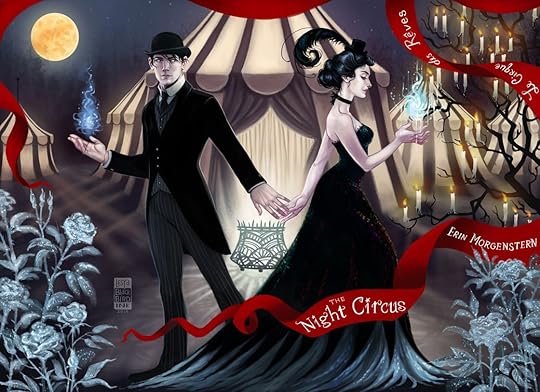 #2 – Incorporate Sensory Details.
#2 – Incorporate Sensory Details.
World-building should be woven into the fabric of your story. Instead of info-dumping exposition, use vivid descriptions and sensory details to bring your world to life.
Think about how your characters experience their surroundings: the smells of a bustling marketplace, the sting of desert sand, the echo of footsteps in a grand palace.
Utilize all five senses to create a vivid setting. Describing what characters see, hear, smell, touch, and taste can make the environment come alive.
In Erin Morgenstern’s enchanting novel The Night Circus, sensory details are employed to evoke the magical atmosphere of a mysterious and whimsical circus that only opens at night. Morgenstern skillfully describes the tantalising aromas of caramel popcorn and spiced cider wafting through the air, the ethereal glow of fairy lights illuminating the tents, the velvet texture of midnight-blue curtains, and the haunting melodies of unseen performers.
Through these sensory descriptions, Morgenstern transports readers into a world where magic feels real and tangible, stimulating their imagination and inviting them to experience the wonder of the circus alongside the characters. The sensory richness of the prose enhances the enchantment and allure of the setting, making The Night Circus a captivating and immersive reading experience..

#3 – Build a History.
Building a rich history for your fictional world adds layers of depth and authenticity, providing context for the current events unfolding within the narrative.
A well-developed history can influence characters’ motivations, shape societal structures, and enrich the overall storytelling experience.
George R.R. Martin’s epic fantasy series A Song of Ice and Fire, which the TV show Game of Thrones is based upon (at least in the first seasons), is renowned for its intricate world-building and sprawling history. Martin delves deep into the history of the Seven Kingdoms of Westeros, chronicling ancient battles, royal lineages, and pivotal alliances that have defined the political landscape. Events such as Robert’s Rebellion, the Targaryen conquest, and the Long Night (a period of darkness and terror) are integral parts of the lore, shaping the characters’ motivations and the overarching conflict of the series.
By weaving this extensive history throughout the narrative, Martin enriches the story with a sense of grandeur and realism, presenting a world that feels lived-in and dynamic. Readers gain a deeper understanding of the characters’ allegiances and rivalries, informed by centuries of historical context.

#4 – Consider Economics and Technology.
Economics and technology are essential in world-building as they shape the socio-political landscape, drive conflicts, and influence characters’ behaviours and motivations. Incorporating economic systems and technological advancements within your fictional world adds layers of realism and complexity. Think about how resources are obtained, distributed, and utilised, as well as the impact of technological innovation on society.
In Frank Herbert’s science fiction masterpiece Dune, the universe is defined by controlling and exploiting a vital resource known as “melange” or “spice.” Spice is a drug-like substance with unique properties that enable space travel and heighten mental abilities. The control of spice production on the desert planet of Arrakis (Dune) is central to the economic and political dynamics of the galaxy.
The spice monopoly, held by the noble House Harkonnen under the guise of the Emperor’s authority, drives the conflict in the story. The lucrative spice trade fuels power struggles among noble houses, the mysterious Bene Gesserit sisterhood, and the enigmatic Fremen tribes native to Arrakis. The economic dependence on spice influences alliances, betrayals, and power plays throughout the narrative.
Furthermore, Dune explores advanced technologies and their impact on society. Using personal shields, ornithopters (flying machines), and the Bene Gesserit’s breeding program demonstrate how technological advancements shape combat tactics, social hierarchies, and cultural norms within the universe.
By integrating complex economic systems and futuristic technologies, Herbert constructs an immersive and authentic world. The economic interdependence driven by spice production and the influence of advanced technology on everyday life contributes to the narrative’s depth and complexity, underscoring the interconnectedness of societal structures and individual motivations.
In summary, Dune exemplifies how considering economics and technology can elevate world-building by creating a rich tapestry of interwoven elements that drive the plot and illuminate the intricacies of the fictional universe. By infusing your world with well-thought-out economic dynamics and plausible technological developments, you can craft a compelling setting that resonates with readers and enhances the narrative’s thematic depth.

#5 – Cultural Diversity and Social Norms.
Cultural diversity and social norms play a crucial role in world-building by adding depth, complexity, and authenticity to fictional societies.
By incorporating diverse cultures and exploring societal norms, writers can create dynamic settings that reflect the richness and complexity of our real world. Introducing cultural diversity within your fictional world allows for exploring different belief systems, traditions, and values that shape characters’ identities and interactions.
On the other hand, social norms establish expectations and rules that govern behaviour within societies, influencing characters’ decisions and motivations. Most importantly, it can create tension and conflict, which are essential to any story.
In Black Panther (2018), the fictional African nation of Wakanda is a vibrant tapestry of diverse cultural influences, each contributing to the nation’s identity and societal structure. Wakanda’s cultural richness is depicted through its distinct tribes, each with its own traditions, rituals, and customs. The film celebrates this diversity, showcasing the various tribes’ unique aesthetics, languages, and spiritual beliefs.
The social norms within Wakanda are shaped by a reverence for tradition and a deep sense of unity. Respect for tribal leadership, collective responsibility, and the belief in technological progress rooted in ancient wisdom are prominent social values. These norms inform the characters’ behaviours, relationships, and decisions, adding depth to their interactions and conflicts.
For instance, T’Challa’s struggle to balance tradition with progress reflects the tension between preserving cultural heritage and embracing innovation. Characters like Nakia challenge societal norms by advocating for global outreach and humanitarian aid, highlighting the complexities of navigating cultural expectations while striving for change.
Black Panther exemplifies how cultural diversity and social norms can enrich world-building by creating an authentic and multifaceted society. By incorporating diverse cultural elements and exploring social dynamics, the film presents a nuanced portrayal of Wakanda as a living, breathing civilisation with its own history, values, and challenges.
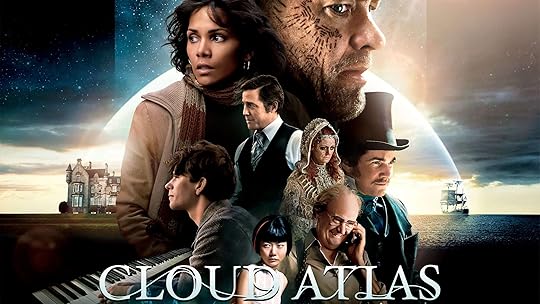 #6 – Use Language Effectively.
#6 – Use Language Effectively.
Using language effectively in world-building involves creating unique dialects, slang, or even constructed languages that enhance the authenticity and depth of fictional cultures. Language can serve as a powerful tool to establish identity, social hierarchy, and cultural nuances within a narrative.
Introducing specialised language or linguistic variations within a fictional world can enrich the storytelling experience by immersing readers or viewers in the nuances of different cultures or societies. Language can reflect societal structures, historical influences, and interpersonal relationships, adding realism and texture to the narrative.
David Mitchell’s novel Cloud Atlas showcases the versatility of language through its narrative structure and linguistic creativity. The novel consists of six interconnected stories spanning different time periods and genres, each featuring distinct styles and dialects that reflect the cultural contexts of their respective settings.
From the 19th-century epistolary style of an American lawyer in the Pacific Islands to the futuristic dialect spoken by a clone in a dystopian future, Mitchell demonstrates a mastery of language to convey the evolution of human communication over centuries. The use of language in Cloud Atlas not only shapes the characters’ identities but also underscores the interconnectedness of humanity across time and space.
By showcasing diverse linguistic expressions and narrative voices, Mitchell crafts a world that transcends conventional boundaries, highlighting the enduring power of language to shape our understanding of the past, present, and future.
[image error]
#7 – Environmental Challenges.
Integrating environmental challenges into world-building not only enhances the realism of a fictional setting but also shapes the characters’ experiences, motivations, and conflicts.
Environmental factors such as climate, geography, and resource scarcity can profoundly influence societies and individuals within a narrative, adding layers of complexity and depth to the storytelling.
Incorporating environmental challenges into world-building involves considering how the physical surroundings impact the characters’ lives and drive the narrative forward. By highlighting environmental hardships or changes, writers can create a dynamic, immersive setting that shapes the plot and character development.
Mad Max: Fury Road (2015) is set in a post-apocalyptic wasteland where resources such as water, fuel, and arable land are scarce. The harsh desert environment is a relentless adversary, shaping the characters’ behaviour and survival instincts. The scarcity of essential resources drives conflicts between competing factions and underscores the struggle for control and dominance.
The environmental challenges depicted in the film are not merely background elements but integral components of the narrative. Water scarcity dictates the behaviour of characters and communities, leading to ruthless battles over control of the few remaining water sources. The barren landscape, marked by sandstorms and extreme temperatures, presents constant physical obstacles that the characters must overcome in their quest for freedom and survival.
Furthermore, the environmental degradation depicted in Mad Max: Fury Road is a cautionary tale about the consequences of human exploitation and disregard for the planet. The film’s dystopian vision underscores the fragility of ecosystems and the catastrophic impact of environmental collapse on civilisation.
By integrating environmental challenges into world-building, Mad Max: Fury Road creates a visceral and immersive experience for viewers. It highlights the profound impact of environmental factors on society and individual behaviour. The hostile landscape becomes a character, driving the narrative forward and adding thematic depth to the film.
In Conclusion – world-building is a critical aspect of storytelling that involves creating immersive and believable settings for narratives to unfold. By implementing key strategies such as establishing clear rules, incorporating sensory details, building rich histories, considering economics and technology, exploring cultural diversity and social norms, using language effectively, and incorporating environmental challenges, writers can craft compelling fictional worlds that resonate with readers or viewers
Now it’s YOUR turn – Which fictional world, from books or movies, has left the strongest impression on you and why?
Would love to get your input in the comment box below.
The post The Magic of World-Building appeared first on Vered Neta.
April 4, 2024
Turning Everyday Life into Literary Gold
In a recent blog post, I discussed overcoming writer’s block. One strategy that consistently helps me navigate those creatively challenging moments is drawing inspiration from the simplicity of everyday life. Forget waiting for lightning to strike. The truth is, that the most profound stories often blossom from the unassuming moments of life.
In our quest for inspiration, it’s easy to overlook the ordinary in favour of the extraordinary. However, by taking a moment to observe the world around us with fresh eyes, we may uncover a wealth of storytelling potential hidden within the seemingly mundane. From the fleeting interactions with strangers to the familiar sights and sounds of our daily routines, there is no shortage of inspiration in life’s unassuming moments.
Today, let’s explore how these seemingly insignificant details have the power to fuel our creativity and breathe life into our writing projects, whether they be novels, screenplays, or any other form of storytelling.
Here Are 5 Ways To Get Inspiration From Everyday Life: #1 – Observation.
#1 – Observation.
One of the simplest yet most effective ways to find inspiration is to observe the world around you.
Pay attention to the people you encounter, the places you visit, and the conversations you overhear. Each interaction has the potential to spark a story or inspire a character.
For example, imagine you’re waiting in line at a coffee shop, and you notice a barista with a tattoo of a dragon on her wrist. Who is she? What’s her story? Suddenly, you have the beginnings of a character for your next script.
Or in a coffee shop, an elderly couple sharing a knowing smile and reminiscing about a past love? That’s a love story waiting to be written or a busy young woman bumping into another guy spilling her coffee all over (him or her) is a typical meet-cute scene for a rom-com.

#2 – Emotions.
Emotions are the heartbeat of storytelling. Tap into your own feelings and experiences to infuse your writing with authenticity and depth.
Think about a moment in your life when you felt joy, sadness, fear, or anger. How can you translate those emotions into your work?
Perhaps you recently experienced the loss of a loved one, and you want to explore themes of grief and healing in your next novel.
Or, if that’s too heavy for you, what about how that unexpected traffic jam made you feel? Use that frustration or amusement to fuel your writing. A character stuck in a traffic jam due to a wacky parade could be the start of a humorous scene or a montage showcasing the city’s vibrant culture.
Drawing from your own emotional landscape can imbue your writing with a powerful resonance that resonates with readers or viewers.

#3 – Everyday Challenges.
Life throws curveballs – use them!
A broken appliance can be a metaphor for a broken relationship in your story or a scene where your characters must work together to fix something, revealing hidden strengths.
Consider the daily challenge of commuting to work. For many, this routine task may seem mundane or even frustrating at times. However, a wealth of storytelling potential lies within the confines of a crowded subway car or a bumper-to-bumper traffic jam.
Imagine a character who embarks on the same daily commute, day in and day out, but finds themselves caught in a series of unexpected events—a chance encounter with a mysterious stranger. This sudden delay sets off a chain reaction of events or even a moment of profound self-reflection prompted by the monotony of their journey.
Through this lens, the mundane act of commuting transforms into a rich tapestry of narrative possibilities. Themes of resilience, serendipity, and personal transformation emerge from the seemingly ordinary backdrop of the daily grind.

#4 – Unexpected Encounters.
Life is full of surprises; sometimes, the most unexpected encounters can lead to the most exciting stories. Keep an open mind and embrace serendipity—you never know where it might lead.
For example, you might strike up a conversation with your neighbour and discover that finally, after years of working as an accountant, he can spend his retirement doing what he loves: gardening. As you listen to him go on and on about his love for gardening, a small girl arrives, smiling and demanding to start working again in the garden. And she’s all excited of going together with him to the next flower exhibition. A fantastic story of friendship between a lonely old man and a young child unfolds in front of you.

#5 – Nature and the Outdoors.
Last and certainly not least, we have the most obvious and used one. For me, nature isn’t just a backdrop for stories—it’s a living, breathing source of inspiration that infuses every word I write.
Every time I step outside, I’m greeted by the symphony of birdsong, the dance of sunlight through leaves, and the ever-changing canvas of the sky. In these moments, surrounded by the beauty and wonder of the natural world, my imagination comes alive.
When I feel stuck or uninspired, a walk in the woods or a stroll along the beach is often all it takes to reignite my creativity. The sights, sounds, and smells of nature awaken my senses and fill me with awe and wonder.
But some of you might live in the heart of the city, surrounded by concrete and skyscrapers, where it’s easy to feel disconnected from nature. Yet, even in the midst of the urban jungle, there are countless opportunities to find inspiration in the outdoors.
Nature isn’t just about escaping to the wilderness—it’s about finding pockets of greenery and tranquillity amidst the hustle and bustle of city life. Whether it’s a small park tucked away between buildings or a rooftop garden with a skyline view, these urban oases offer a welcome respite from the chaos of the city streets.
Moreover, city parks offer a wealth of opportunities for outdoor recreation and inspiration. Whether it’s taking a jog along a scenic trail, picnicking in the shade of a tree, or simply people-watching from a bench, spending time in the park allows me to reconnect with the rhythms of the natural world and find inspiration in the beauty of everyday life.
And let’s not forget about the power of water in the cityscape. Whether it’s a stroll along a riverfront promenade or simply sitting by a fountain in a bustling plaza, the sight and sound of water can have a calming effect, transporting me to a place of peace and serenity amidst the urban chaos.
In the end, nature is all around us, even in the heart of the city. We can find inspiration, solace, and beauty in the most unexpected places by seeking out these urban oases and embracing the natural world in our everyday lives.
In Conclusion – finding inspiration in writing in everyday life is all about opening yourself up to the world around you and embracing the richness of human experience. By observing, reflecting, and drawing from your own life and the lives of others, you can transform the ordinary into the extraordinary and create stories that resonate with readers and viewers alike.
So the next time you find yourself struggling to find inspiration, remember that inspiration is all around you—you just have to open your eyes and see it.
Now it’s YOUR TURN –What’s your go-to strategy for finding inspiration in everyday life? We’d love to hear your creative tips and tricks!
Would love to get your input in the comment box below.
The post Turning Everyday Life into Literary Gold appeared first on Vered Neta.
March 28, 2024
Conquering the Blank Page
Last week was a tough one for me. I had set a deadline to complete my Pilot episode before the end of the month. Everything seemed crystal clear in my mind – I was the hero of my own story, and my ideas were brilliant.
But when I sat down to write, it felt like hitting a brick wall. Either nothing came out, or worse, the words that did materialise on the page sounded like utter rubbish – maybe even the worst thing ever. It was a constant cycle of typing, deleting, and staring at a blank screen.
Can you relate? If so, you’ve likely tangled with that infamous beast known as writer’s block. Determined to conquer it, I took matters into my own hands. Instead of banging my head against the keyboard trying to force out my Pilot, I decided to tackle the block head-on. Some might call it a detour into “Procrastination Land”, but I saw it as a necessary pit stop on the road to progress. After a bit of digging and experimentation, I uncovered some simple yet powerful strategies to slay the monster once and for all.
And you know what? It worked! Armed with newfound techniques, I defeated writer’s block and finished that dreaded Pilot a full week ahead of schedule.
So here Are 7 Ways to Overcome Writer’s Block

#1 – Freewriting: Let Your Pen Run Wild.
Ever feel like the weight of the world is resting on your shoulders as soon as you sit down to write? It’s like the pressure to produce a literary masterpiece straight out of the gate puts a serious damper on your creative mojo.
That’s where freewriting swoops in to save the day! Say goodbye to that pesky perfectionism that’s been cramping your style and hello to a liberating writing experience.
With freewriting, you can finally kick that inner editor to the curb and let your ideas flow freely, like a river in full flood. Forget about grammar, spelling, or even making sense—just let your thoughts spill onto the page like confetti at a party.
Trust me, it’s a game changer! By loosening those inhibitions, you’ll be amazed at the unexpected gems that emerge from the depths of your imagination.
 #2 – Change Your Scene, Change Your Game!
#2 – Change Your Scene, Change Your Game!
Ever feel like you’re going around in circles, stuck in the same old routine? It’s like being trapped in a creativity-quashing vortex! But fear not—there’s a simple solution: shake things up and change your writing environment.
Think about it—when you’re stuck in the same old surroundings day in and day out, it’s no wonder your creativity starts to feel like it’s on life support.
But by stepping out of your comfort zone and changing your scenery, you can breathe new life into your ideas faster than you can say “Writer’s block is gone!”
Whether you’re swapping your desk for a cosy corner in a coffee shop, trading four walls for the great outdoors in a park, or simply moving to a different room in your house, the possibilities are endless. And let me tell you, the results are nothing short of magical!
Exposing yourself to new sights, sounds, and smells is like giving your brain a much-needed shot of espresso. Before you know it, those fresh surroundings will kickstart your creativity and reveal a treasure trove of ideas hiding just beneath the surface. So go ahead, change up your space, and prepare to be amazed as new ideas start popping up like wildflowers in spring!

#3 – Brainstorm Bonanza!
Have you ever had that sinking feeling when you’re staring at a blank page, not knowing where to begin or which way to turn? Writer’s block loves to strike when you least expect it, leaving you feeling lost in a sea of uncertainty. But fear not—brainstorming is here to save the day!
Picture this: you’re sitting down with a friend, a trusted writing partner, or even a lively online forum, bouncing ideas off each other like a game of verbal ping-pong. Suddenly, those roadblocks that seemed insurmountable start to crumble before your eyes, and the floodgates of creativity swing wide open. That’s the power of brainstorming!
By teaming up with others and diving headfirst into a brainstorming session, you’re not just chipping away at writer’s block—you’re demolishing it brick by brick. Together, you’ll explore a vast landscape of ideas, unearthing unexpected connections and uncovering hidden gems along the way. And the best part? There’s no judgment here. It’s a safe space to let your imagination run wild, free from the shackles of self-doubt.
So what are you waiting for? Grab a buddy, fire up that online forum, and get ready to embark on a brainstorming adventure like no other. If you’re still hesitating, I’m always here for you, just email me at news@veredneta.com and we can schedule a brainstorm for just the two of us or more people if you wish.

#4 – Take Breaks Like a Boss!
Who says writing is a marathon? Take it from me: even the pros need to recharge their batteries. Pushing through mental fatigue can worsen writer’s block, leading to frustration and burnout.
But here’s the secret sauce: take a breather, step away from your writing, and give your beautiful brain a chance to kick back and relax. Seriously, it’s like giving your creativity a spa day!
When you come back to your writing with fresh eyes and a renewed sense of energy, you’ll be blown away by how much more productive and inspired you become. So go ahead, take that well-deserved break. Your writing—and your sanity—will thank you for it!

#5 – Set Goals You Can Actually Crush!
Setting unrealistic goals is like signing up for a stress-packed trip straight to Stressville. I’ve been there, done that, and got the T-shirt—it’s not pretty! When you aim for the stars and end up feeling like you’re drowning in a sea of overwhelm, it’s no wonder writer’s block comes knocking at your door.
The silver lining in this storm cloud is simple. Instead of shooting for the moon and getting lost in space, why not break your writing tasks down into bite-sized pieces? Trust me, it’s like hitting the reset button on your productivity meter! By focusing on achievable milestones and celebrating each little victory along the way, you’ll build momentum faster than you can say “writer’s block who?”
So raise a toast to small wins and manageable goals! With each step forward, you’ll inch closer to banishing writer’s block for good. Remember, Rome wasn’t built in a day—and neither is your masterpiece. So take it one step at a time, and before you know it, you’ll be crossing the finish line with a smile on your face and a story in your heart.
 #6 – Seek Out Inspiration Everywhere!
#6 – Seek Out Inspiration Everywhere!
Feeling uninspired? It’s time to go on an inspiration scavenger hunt!
Writer’s block often rears its ugly head when we’re feeling disconnected from our creative spark.
But here’s the secret sauce: Surround yourself with sources of inspiration, whether diving into your favourite books, cranking up your favourite tunes, or immersing yourself in a gallery of stunning artwork. You’ll be amazed at how quickly your creative fire can reignite!

#7 – Embrace the Imperfect Draft!
And last but not least, my all-time-favourite – the age-old fear of failure – the ultimate dream crusher. The one that paralyzed me last week. It’s like standing at the edge of a diving board, too scared to take the plunge for fear of belly-flopping spectacularly.
But guess what? Perfectionism? is the villain in your creative story, lurking in the shadows and whispering sweet nothings about how everything has to be flawless from the get-go.
But here’s the truth bomb: Progress Trumps Perfection Every Single Time!
So, let’s rewrite the script. Picture this: you, armed with nothing but a pen and paper (or a trusty keyboard if you’re feeling fancy), diving headfirst into the creative abyss with wild abandon. Your mission? To unleash those wild ideas swirling around in your head onto the page without a care in the world for how messy or imperfect they may seem.
Because here’s the thing: that first draft? It’s like the rough sketch of a masterpiece waiting to be brought to life. It doesn’t have to be perfect – it just has to exist!
So go ahead and give yourself permission to embrace the chaos, knowing that you can always refine and polish those rough edges later on.
Remember, every word you write is a victory in itself – a tiny triumph over that sneaky fear of failure. So let’s raise a toast to progress, imperfections and all. After all, it’s the journey that counts, not the destination. And trust me, when you finally take that leap and start putting pen to paper, you’ll wonder why you ever let fear hold you back in the first place.
In Conclusion – Remember, writer’s block is just a temporary hurdle. By using these strategies, you can silence the blinking cursor, unleash your inner wordsmith, and transform that blank page into a masterpiece. Now get out there and write something amazing!
Now it’s YOUR turn – I would love to hear your tips on overcoming Writer’s Block.
Would love to get your input in the comment box below.
The post Conquering the Blank Page appeared first on Vered Neta.
March 21, 2024
History with a Twist – Exploring the Brilliance of ‘The Great'”
I Love History!
I love historical novels, movies and TV shows. I’ve written several blog posts on how to avoid pitfalls in writing historical novels and TV shows. Having said that, it’s such a refreshing thing to watch the TV show “The Great”. It puts a whole different spin on what a historical movie/TV show should be.
History on television can sometimes feel stuffy, bogged down by accuracy. But then there’s “The Great,” a show that throws historical fact out the window in favour of a wildly entertaining, darkly comedic take on Catherine the Great’s rise to power.
Here Are 8 Reasons Why “The Great” is Royally Awesome.

#1 – Satire with a Bite.
Forget damsels in distress. Catherine (Elle Fanning) is a firecracker trapped in a backward court. Her sharp wit and frustration clash brilliantly with the scheming advisors and her clueless, often cruel husband Peter (Nicholas Hoult).
But “The Great” goes beyond humour. It uses satire to skewer the absurdity of absolute power and unchecked ambition. Take, for example, the scene where Catherine proposes a public library, only to be met with Peter’s ridiculous suggestion of filling it with pictures of himself hunting bears. This perfectly encapsulates the show’s ability to use humour to expose the folly of unchecked power.
Another brilliant example is the ongoing debate about the merits of forks versus hands. While seemingly absurd, it highlights the clash between Catherine’s desire for modernisation and the entrenched resistance to change within the court.
 #2 – History Unbuttoned.
#2 – History Unbuttoned.
Ditch the stuffy costumes and predictable plots. “The Great” embraces anachronisms and absurdity. The costumes are a playful mix of historical inspiration and modern flair, with fur-trimmed jackets that wouldn’t look out of place on a contemporary runway.
The dialogue sparkles with contemporary references, with characters dropping terms like “hot mess” and “guilt trip.”
The court itself feels more like a dysfunctional family reunion than a seat of power. Imagine a lavish palace filled with gossiping courtiers, drunken brawls, and power struggles that would make a modern reality show look tame. That’s the kind of refreshingly unstuffy history “The Great” delivers
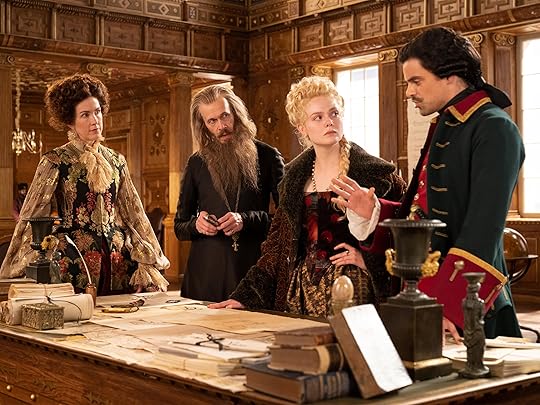
#3 – Characters You Can’t Look Away From.
“The Great” boasts a cast that steals every scene. Fanning is a revelation as Catherine, capturing both steely determination (remember the empowering scene where she declares, “I will be the ruler!”) and a vulnerability that makes you root for her.
Hoult is equally brilliant as the unpredictable Peter, a strangely endearing man-child king. He delivers his lines with hilarious deadpan humour, as seen in the scene where he casually suggests setting fire to a rival’s beard.
From the scheming Orlo (Sacha Dhawan), whose double-dealing is as captivating as it is untrustworthy, to Catherine’s loyal confidante Marial (Phoebe Fox), who provides a voice of reason amidst the chaos, the supporting cast is a treasure trove of captivating personalities.
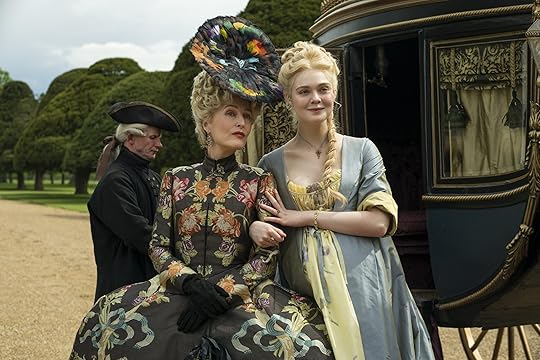
#4 – A Celebration of Women’s Power.
Don’t be fooled by the laughs. “The Great” tackles serious issues of gender inequality.
Catherine’s journey is one of defying expectations and forging her own path in a world dominated by men. In a particularly powerful scene, Catherine confronts a group of dismissive noblemen, declaring her right to rule.
The show sheds light on the power struggles within a historical context, offering a fresh perspective on women’s roles in society. Catherine’s transformation from a naive bride, constantly underestimated by the men around her, to a formidable ruler who demands respect is a testament to the show’s empowering message.

#5 – Visually Striking & Audacious.
“The Great” isn’t just funny, it’s visually stunning. The palace interiors are opulent eye candy, with colour and extravagant details.
Think jewel-toned walls, glittering chandeliers, and enough fur to make a yeti jealous. Yet, a sense of danger and claustrophobia lurks beneath the surface, reflecting the precariousness of Catherine’s position. The camerawork is equally masterful.
Take, for instance, the scene where Catherine and Peter walk through a long, echoing hallway, the camera emphasising the vastness of the palace and the isolation of their positions. The editing is sharp and dynamic, adding another layer to the show’s unique tone.
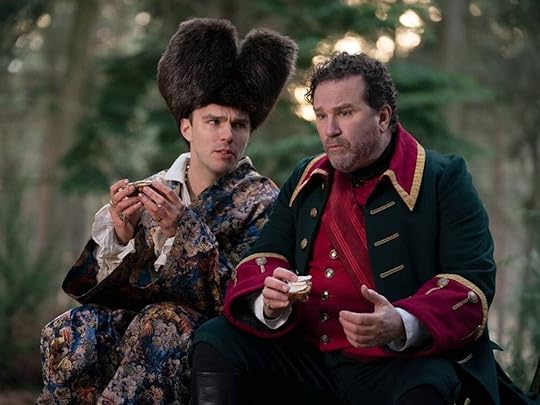 #6 – Sharp Dialogue and Wordplay.
#6 – Sharp Dialogue and Wordplay.
The script crackles with brilliance. Dialogue is a delightful blend of sharp observations, laugh-out-loud moments, and clever wordplay. The use of modern references is particularly impressive, keeping you guessing and engaged.
In one witty exchange, Catherine describes the court as a “clusterfudge,” a hilarious anachronism that perfectly captures the situation’s absurdity.
Another laugh-out-loud moment comes when Peter, frustrated by Catherine’s attempts at reform, declares that the peasants need “bread and less, uh…enlightenment.”

#7 – Perfect Blend of Drama and Comedy.
“The Great” seamlessly weaves together drama and comedy. It effortlessly shifts between moments of high tension and laugh-out-loud humour, keeping you on the edge of your seat while tickling your funny bone.
One minute, you might be worried about Catherine’s safety as she navigates the treacherous court, and the next, you’re doubled over with laughter at Peter’s latest ridiculous antics.
Remember the scene where Catherine and her allies are desperately trying to secure her future, only to be interrupted by a bumbling attempt at a coup by a group of drunken guards? It’s a perfect example of how the show balances humour and suspense.
 #8 – Nuanced Character Development.
#8 – Nuanced Character Development.
“The Great” excels in character development. Each character embarks on a transformative journey, grappling with their desires, flaws, and moral dilemmas. Whether it’s Catherine’s thirst for power, Peter’s insecurities, or the court’s scheming games, each character is given depth and complexity, making the narrative all the more intriguing.
Catherine, for instance, starts out as a young woman yearning for love and a better life. But as she navigates the brutal realities of court life, she transforms into a shrewd and cunning ruler.
Peter, on the other hand, is initially portrayed as a buffoonish oaf. However, glimpses of his intelligence and vulnerability emerge throughout the story, making him a surprisingly compelling character. Even minor characters like Orlo keep you guessing. Is he truly devoted to Catherine, or is he playing his long game? This constant sense of surprise and character development keeps you invested in the story.
The Verdict: A Show Fit for a Tsar (or Just You on Your Couch) – “The Great” isn’t your typical history lesson. It’s a show that sparks curiosity about the period while entertaining you with its dark humour, sharp wit, and compelling characters. It proves you can learn something new while laughing until your sides hurt. So, ditch the documentaries and dive into the hilarious world of “The Great.” You won’t regret it.
Now it’s YOUR turn – I would love to hear your thoughts about he show.
Would love to get your input in the comment box below.
The post History with a Twist – Exploring the Brilliance of ‘The Great'” appeared first on Vered Neta.



